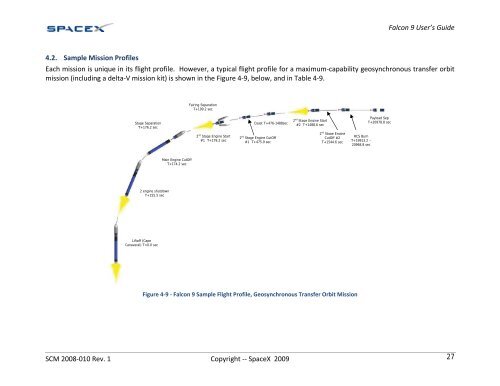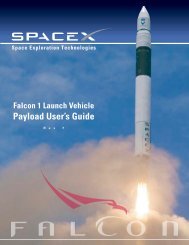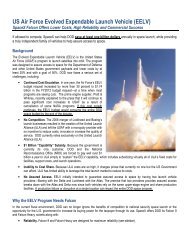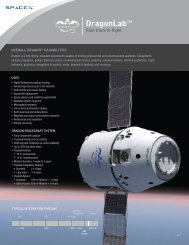Falcon 9 Launch Vehicle Payload User's Guide - SpaceX
Falcon 9 Launch Vehicle Payload User's Guide - SpaceX
Falcon 9 Launch Vehicle Payload User's Guide - SpaceX
You also want an ePaper? Increase the reach of your titles
YUMPU automatically turns print PDFs into web optimized ePapers that Google loves.
<strong>Falcon</strong> 9 User’s <strong>Guide</strong><br />
4.2. Sample Mission Profiles<br />
Each mission is unique in its flight profile. However, a typical flight profile for a maximum‐capability geosynchronous transfer orbit<br />
mission (including a delta‐V mission kit) is shown in the Figure 4‐9, below, and in Table 4‐9.<br />
Stage Separation<br />
T+176.2 sec<br />
2 engine shutdown<br />
T+155.5 sec<br />
Liftoff (Cape<br />
Canaveral) T=0.0 sec<br />
Main Engine CutOff<br />
T+174.2 sec<br />
Fairing Separation<br />
T+199.2 sec<br />
2 nd Stage Engine Start<br />
#1 T+179.2 sec<br />
Coast T+476-1488sec<br />
2 nd Stage Engine CutOff<br />
#1 T+475.9 sec<br />
2 nd Stage Engine Start<br />
#2 T+1488.6 sec<br />
2 nd Stage Engine<br />
CutOff #2<br />
T+1544.6 sec<br />
Figure 4‐9 ‐ <strong>Falcon</strong> 9 Sample Flight Profile, Geosynchronous Transfer Orbit Mission<br />
RCS Burn<br />
T+19913.2 –<br />
20968.8 sec<br />
<strong>Payload</strong> Sep<br />
T+20978.8 sec<br />
SCM 2008‐010 Rev. 1 Copyright ‐‐ <strong>SpaceX</strong> 2009 27





